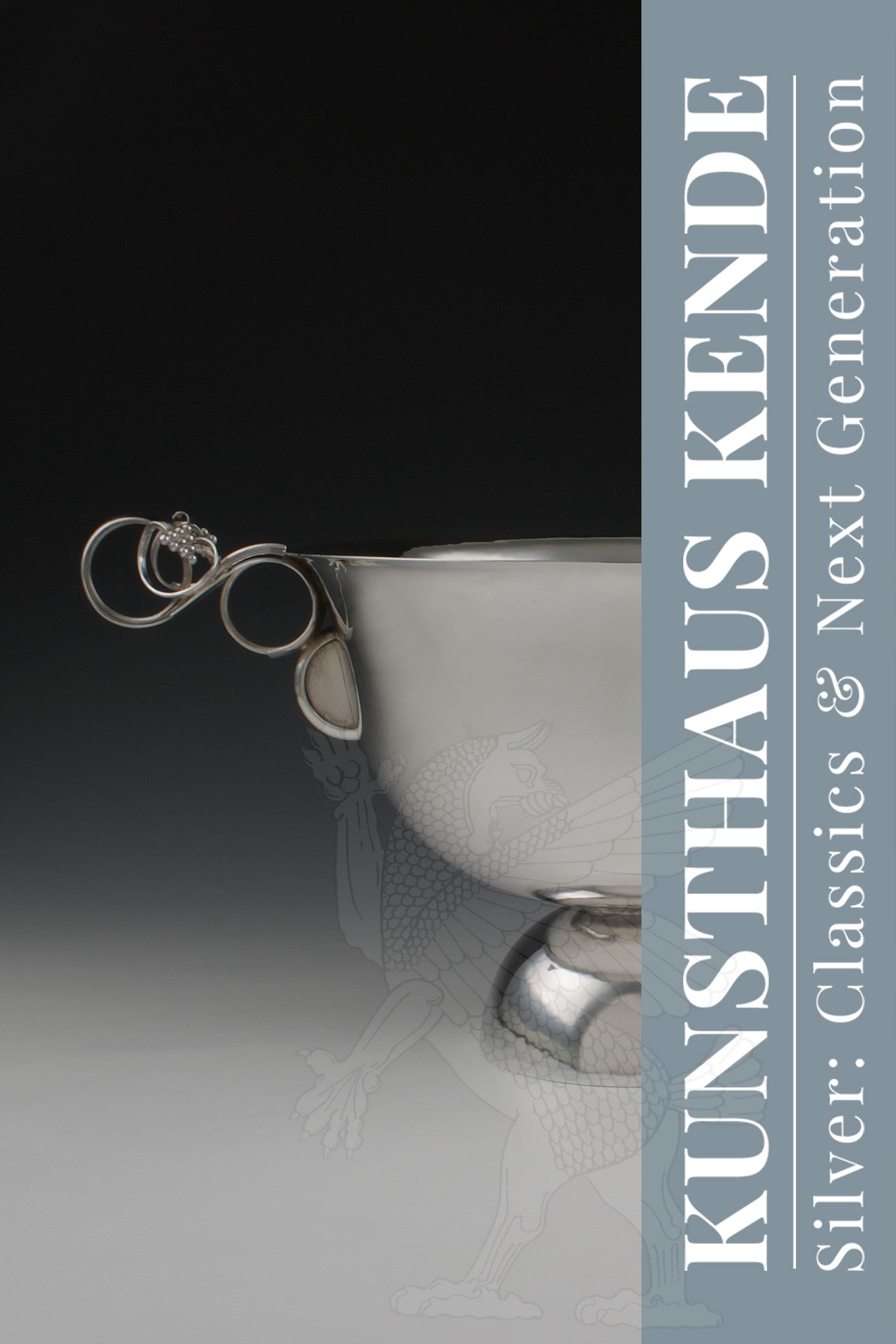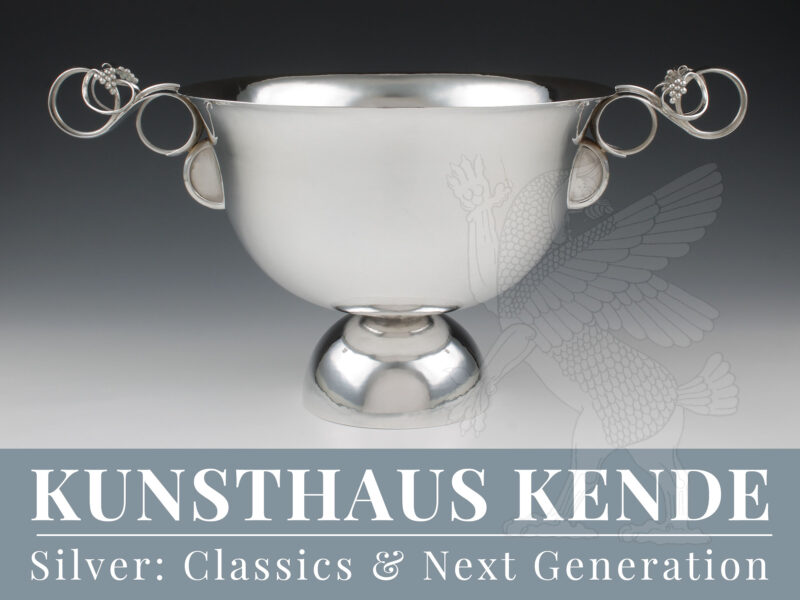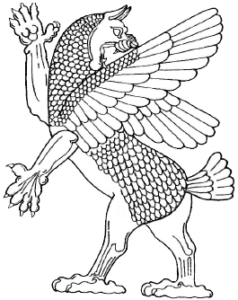Item number: 60138
A large Art Déco fruit bowl 800 silver Heilbronn 1927-30,
by Paula Straus for Bruckmann & Söhne
The base and the bowl consisting of two cut spherical bowls of different sizes with subtly hammered surface that meet at their peaks. The slightly convex upper rim decorated at both ends by the ring-shaped handles in Art Deco motifs that are characteristic of Paula Straus and abstract vine tendrils.
Extremely rare work by one of the most important lady silversmiths of German Art Déco in very beautiful and authentic condition.
41.9 cm / 16.49″ length, 25.6 cm / 10.07″ diameter, 19.4 cm / 7.63″ tall (to the rim); 1094.8 g / 35.19 oz
The special position of this silver bowl within Paula Straus’ artistic oeuvre is also illustrated by the fact that it was depicted on the outer cover of the accompanying publication “Frauensilber – Paula Straus, Emmy Roth & Co. Silberschmiedinnen der Bauhauszeit” for the 2011 special exhibition at the Bröhan Museum in Berlin and the Badisches Landesmuseum Karlsruhe. A contemporary illustration of the bowl can also be found in Eduard Reinacher (ed.): Dekorative Kunst – Illustrierte Zeitschrift für angewandte Kunst, Munich 1929. Vol. XXXVII, p. 240 (see here).
The silver bowl was shown in 1927 as part of the exhibition “Europäisches Kunstgewerbe” at the Grassimuseum Leipzig together with a coffee and tea service by the artist. The bowl with the model number 13086 was available in two different sizes, our example is the larger one.
A counterpart is now in the Bröhan Museum, Berlin, in whose inventory catalogue the bowl is also illustrated on p. 116 in the 2011 edition. In addition to the publications mentioned above, this bowl can be found in various other books. In addition to the illustration of the object, its construction drawing can also be found in: Monika Sänger (ed.): Paula Straus – Vom Kunsthandwerk zum Industriedesign, Stuttgart 2023. p. 121.
The jewish lady silversmith and designer Paula Straus (Stuttgart 1894 – Auschwitz 1943)
Important german avant-garde goldsmith and designer of jewellery, silverware and flatware in Stuttgart.
Trained at the Kunstgewerbeschule Stuttgart (School of Applied Arts, Stuttgart) until 1921, Paula Straus was a master student in the metal class taught by Paul Haustein, who also designed silverware for Bruckmann & Söhne and the Württembergische Metallwarenfabrik Geislingen (WMF). The collaboration with Paul Haustein as well as with the department for glass and stone cutting at the Kunstgewerbeschule under Wilhelm von Eiff continued after her graduation. From 1924/25 until the early 1930s, Paula Straus worked as a designer of silverware for Bruckmann & Söhne in Heilbronn, where she designed an impressive variety of silverware, especially silver tea sets, silver hollowware and silver cutlery as well as ecclesiastical silver for both Christian and Jewish liturgy. Her outstanding artistic position was also reflected in the fact that she was one of the few silversmiths and designers to be given her own studio by Bruckmann & Söhne.
Together with Josef M. Lock, she was in charge of the studio for ecclesiastical silver at Bruckmann & Söhne from 1925-30. In 1929, Paula Straus received a teaching assignment at the Staatliche Hochschule für Handwerk und Baukunst in Weimar (State College for Crafts and Architecture). From 1933 she worked as a master goldsmith at WMF. Two years later, Paula Straus decided to become self-employed and moved to Stuttgart in 1935, where she founded a jewellery shop that was closed by the National Socialists in 1939. In reaction to the Night of Broken Glass of 9-10 November 1938, Paula Straus made numerous attempts to emigrate and negotiated with the Zilverfabriek Voorschoten in the Netherlands, where her fellow artist Christa Ehrlich held a prominent position as a designer and for whom Emmy Roth also conceived numerous designs for silverware. From this period, individual photographs of Paula Straus’ designs for silverware, silver cutlery as well as tea services have survived, summarised in an application folder, the authorship of which would remain unknown today. After the expropriation of her properties in Stuttgart and Gundelfingen (1939/40), she had to give up her work as a goldsmith and silversmith for good and instead take up a position as a kitchen assistant at the Jewish old people’s home in Buttenhausen near Münsingen. In 1941, she became the manager of the Jewish nursing home in Haigerloch, which she had to run together with a kitchen assistant under the most adverse circumstances.
On 2nd August 1942, Paula Straus was deported to Theresienstadt together with her mother and in January 1943 she was transferred to Auschwitz, where she was murdered on 10th February.
Paula Straus’s designs for silverware and silver cutlery were so modern and progressive that she managed to formally anticipate the work of the 1950s and in the meantime to refer back to the classicist silver works of the 18th century. A very thoughtful use of ornamentation often reduces the austerity of her designs and minimises their monumental character.
Under more favourable conditions, the artistic potential of Paula Straus would have made her an internationally respected artist, who would not have had to shy away from a comparison with Emile Lettré, Jean Emile Puiforcat or Georg Jensen in any way.





